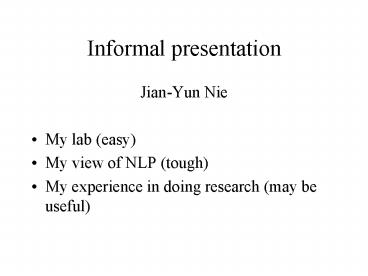Informal presentation - PowerPoint PPT Presentation
1 / 17
Title:
Informal presentation
Description:
Dept. of Computer science and operations research, University of Montreal, Canada ... Translations made by statistical MT are often unreadable ... – PowerPoint PPT presentation
Number of Views:20
Avg rating:3.0/5.0
Title: Informal presentation
1
Informal presentation
- Jian-Yun Nie
- My lab (easy)
- My view of NLP (tough)
- My experience in doing research (may be useful)
2
1. Presentation of RALI lab.
- Dept. of Computer science and operations
research, University of Montreal, Canada - RALI Recherche Appliquee en Linguistique
Informatique (Applied Research in Computational
Linguistics) - One of the largest labs in CL in Canada
- Long tradition of MT
3
Personnel
- 3 professors
- G. Lapalme Text generation, Info. Extraction,
QA, Text summarization - Ph. Langlais Statistical MT
- J.Y. Nie IR and some NLP
- 5 researchers
- 20 graduate students
4
Research projects
- Translation
- TransType suggest translation words/expressions
- TransTalk Speech input of translation
- TransSearch Search for translations in parallel
texts (Hansards) - TransCheck check for trans. errors
- IE
- Automatic email answering (from customers)
- QA
- Text summarization
- Scientific articles simulate a human summarizer
- Law documents
- Arabic texts
5
Research projects
- IR
- IR models (logic models, language models, etc.)
- Inferential IR (how to reason in IR?)
- CLIR (English-French, Chinese, etc.)
- Text mining (mining parallel texts from the Web)
for query translation - Business intelligence (application of IR)
- Fining relevant calls for tenders
- Mining info. about companies
- Classification of calls for tenders
6
Current research projects in IR
- Integrating term relationships into language
models - CLIR using statistical translation model
- Improving translation models for query
translation - Mining parallel texts and filtering noise
- Classification using language models, compound
terms etc. - User- and domain-dependent IR (user profile)
- Law document retrieval using hyperlinks
- Image retrieval (cross-media IR)
7
Tools
- SILC (automatic identification of language and
coding) - PTMiner (Parallel Text mining)
- TransSearch (transferred to a company)
8
2. My view of NLP
- Many interesting subjects to be explored
- Combining rules with statistics
- Exploring more learning methods for NLP
(exploiting the mass of data) - History
- Rule-based
- Statistical approaches
- McKey
- Proper places of man and machine
- Combination of rules and statistics
- Statistics can help choose appropriate rules
- Many rules cannot be learnt through statistics
(at least for now)
9
Example Machine aided human translation
- Statistics can help select translation
words/terms - But is unable to deal with grammars and meaning
- Machine makes suggestions, and human makes the
final translation
10
Example MT
- Translations made by statistical MT are often
unreadable - Why not use rules to improve readability?
- Question what is the proper places of man
(rules) and machine (statistics)? How to make
them working together?
11
Exploiting the mass of data
- New translations extract from data (the Web)
- New terms
- New rules
- At least frequency
12
3. My own experience in doing research
- Paper structure
- Introduction of the problem, motivation of the
research - Existing methods
- New methods
- Modification of an existing one
- Borrow a method from a different area
- Create a completely new method
- Implementation
- Experiments/analysis
- Conclusion
- Research planning similar to paper structure
13
Two types of researchers
- I have a hammer, and everything looks like a nail
(opportunistic) - I have a problem, and I try to use every possible
method
14
My way of doing research
- Determining an interesting research problem
- Not solved, not trivial
- Possibility to find a solution
- In my area of research
- Being aware of the existing methods
- Reading papers, but with a critical eye
- Finding possible improvements, new solutions
- First intuitively, then formulate with more rigor
- Implementation and experiments
- Analysis of the results (to find possible
improvements, and to understand better the
problem)
15
My way of doing research
- Improve the writing skills (very critical for a
researcher) - A long learning process
- Observe how the others write papers and correct
my papers - Imagine Im a reader, and try to see if the
description can follow smoothly, and is clear to
a non-specialist reader - Is the logic of my description clear, and easy to
follow? - Whole structure
- Description of a specific element
- Is a term used ambiguous and not clear? Can I use
a better term? - Is the description monotonic/repetitive/boring
- Is there a hole?
- Have I made my idea clear enough? How can I make
it clearer? - The reader (reviewer) wants to understand, so try
to help him/her - What is not clear is not necessarily profound, it
can also be obscure - Complex math. formulas ? good paper
16
Some common problems
- Superficial
- Introducing new concepts without introducing new
methods - Too ambitious but without concrete support
- Doing research in isolation
- No literature review
- No comparison with others
- No (not enough) justification of the method
- Logic not clear in description
- Big holes (an important notion not explained,
two pieces of description are not coherent, ) - Unrelated description
- Experiments not rigorous
- Trace of manipulation of experimental results
- English (but often not the main reason)
17
Recommendation
- Read papers
- Observe the writing
- Write papers
- Read your own papers as a reader
- Ask your colleagues to read your papers and to
tell you what is not clear - Read and analyze carefully the corrections by the
others































